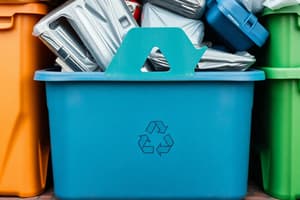Podcast
Questions and Answers
What is the first step in starting a recycling project?
What is the first step in starting a recycling project?
- Prepare a project outline
- Plan what to recycle (correct)
- Choose the materials needed
- Study the project design
Which of the following is NOT a part of a project plan for recycling?
Which of the following is NOT a part of a project plan for recycling?
- Estimated Budget (correct)
- Tools and Materials
- Name of Project
- Objectives
What should you do after choosing the design for your recycling project?
What should you do after choosing the design for your recycling project?
- Draw a detailed illustration
- Start collecting materials immediately
- List the materials needed (correct)
- Define the main objectives
Which aspect of a project plan outlines the steps to be followed in making the project?
Which aspect of a project plan outlines the steps to be followed in making the project?
In planning a recycling project, what is emphasized as important when preparing to work on the project?
In planning a recycling project, what is emphasized as important when preparing to work on the project?
What is one of the major environmental benefits of recycling?
What is one of the major environmental benefits of recycling?
Which type of waste is most commonly associated with packaging?
Which type of waste is most commonly associated with packaging?
How does recycling contribute to job creation?
How does recycling contribute to job creation?
Which of the following is NOT a benefit of recycling?
Which of the following is NOT a benefit of recycling?
What is a key aspect of properly disposing of waste?
What is a key aspect of properly disposing of waste?
What characteristic of plastics raises environmental concerns?
What characteristic of plastics raises environmental concerns?
Which example is a type of waste that can be recycled from construction?
Which example is a type of waste that can be recycled from construction?
What responsibility should individuals take to support recycling efforts?
What responsibility should individuals take to support recycling efforts?
Flashcards
Planning a Recycling Project
Planning a Recycling Project
The first step in any recycling project is careful planning.
Project Plan
Project Plan
A comprehensive guide that outlines the entire recycling project, from planning to execution.
Objectives of a Project Plan
Objectives of a Project Plan
A well-defined description of the final outcome of the recycling project, including purpose and expected results.
Design or Drawing of a Project
Design or Drawing of a Project
Signup and view all the flashcards
Procedure of a Project Plan
Procedure of a Project Plan
Signup and view all the flashcards
What is recycling?
What is recycling?
Signup and view all the flashcards
What are the benefits of recycling?
What are the benefits of recycling?
Signup and view all the flashcards
How does recycling affect the environment?
How does recycling affect the environment?
Signup and view all the flashcards
What are some examples of recyclable materials?
What are some examples of recyclable materials?
Signup and view all the flashcards
What is construction and demolition waste?
What is construction and demolition waste?
Signup and view all the flashcards
What is municipal solid waste?
What is municipal solid waste?
Signup and view all the flashcards
What are other types of waste?
What are other types of waste?
Signup and view all the flashcards
What are creative projects using recycled materials?
What are creative projects using recycled materials?
Signup and view all the flashcards
Study Notes
Learning Targets
- Students should be able to explain the importance of recycling.
- Students should demonstrate enthusiasm and responsibility in creating a project that can be reused or sold.
- Students should create a project plan.
- Students should create a project using recyclable materials.
What You Need To Know
- Improper waste disposal is a global problem.
- This leads to pollution, flooding, disease spread, threats to marine life, and an overall unsafe and uncomfortable environment.
- Recycling is a process where materials are reprocessed to create new products, instead of being discarded as waste.
Benefits of Recycling
- Recycling helps protect the environment.
- Recycling creates job opportunities and generates income.
- Recycling lessens greenhouse gas emissions from factories, thus contributing to climate change mitigation.
- Recycling conserves energy.
- Recycling plays a part in fuel production.
- Recycling improves soil quality.
- Recycling decreases the need to harvest new raw materials.
Identifying Recyclable Products/Waste Materials
- Containers and packaging are a major category of waste products.
- Food and non-food items typically come in containers made from various materials like plastic, glass, metal, paper, and combinations of these.
- Thin plastics are commonly found in packaging but many locations prohibit their use due to non-biodegradability.
- Recyclable materials can be used for creative projects.
Types of Recyclable Waste
- Construction/Demolition waste (e.g., concrete, wood, metal, plastic, glass, doors, windows).
- Municipal Solid Waste (household/commercial waste).
- Miscellaneous waste (items that can be repurposed into useful or decorative items—e.g., used notebooks, empty bottles).
Planning a Project for Recycling
- Careful and systematic planning is essential for successful recycling projects.
- The plan should detail the materials needed, the project steps, and the project design.
Parts of a Project Plan
- Project Name
- Project Objectives (reasons behind the project)
- Tools and Materials (items needed)
- Design/Drawing of the project (illustration of the intended final product).
- Procedure (steps to complete the project).
Sample Project Outline
- The example outline is for a recycled paper notebook.
- The project includes objectives, materials needed, design, procedures, and potential activities.
Studying That Suits You
Use AI to generate personalized quizzes and flashcards to suit your learning preferences.




